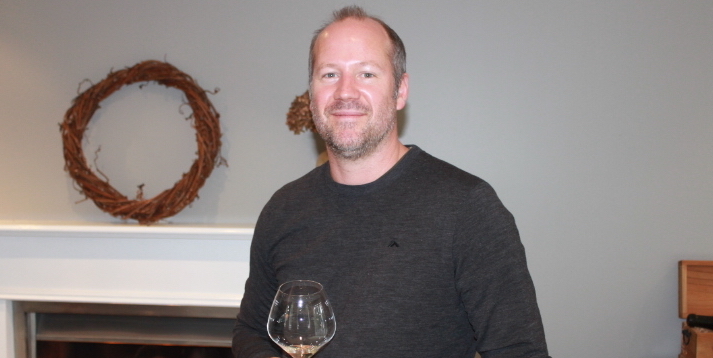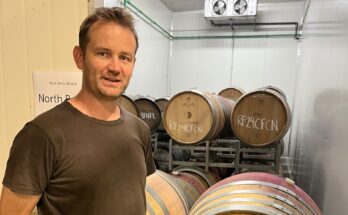WineFolio dropped into the Te Awa winery complex, which now houses the Villa Maria family of brands. It’s our first visit since this amalgamation, and we took the chance to talk to one of the winemakers from this stable – Richard Painter, about the Vidal brand, but also the other wines he is responsible for..
Richard Painter: Villa Maria is obviously our parent company, still privately owned by Sir George Fistonich and his family, and then we have these brands that come under it. Te Awa and Leftfield are the ones I look after, then we’ve got Vidal and Esk Valley and of course Villa Maria wines. A lot of our vineyards are managed by a viticulture team, but each brand has either its own vineyards or own parts that it works with every year. And then each winemaking style is a bit different as well. The brands are all quite individual, there’s a real difference in style. About three years ago we built the new winery just to consolidate all our winemaking into one facility.
WF: Do people have their own space? Does Gordon still have his concrete fermenters?
RP: He’s got his concrete fermenters, yes. There are some tanks from Te Awa and some from Vidal also. In terms of barrel cellars, you keep all the barrels together, but we don’t have enough space to be too separated.
Vidal was started in 1905 by Antony Vidal, and only moved from their place in Hastings in 2018. The wines we’ll try are all 2017, which was the last vintage at the old winery. We’ll do the Hawke’s Bay classics today – Chardonnay, Syrah and the red blends. We make loads of Pinot Gris and everything else from Hawke’s Bay, but those are our classic styles.
WF: What do you think about when someone from Hawke’s Bay – maybe a classic brand, does something like a Pinot or a Sauvignon Blanc? Those aren’t generally from here – they could be, and are grown here, but those are considered wine varieties from other regions?
RP: Vidal is a classic example – there’s a Marlborough Sauvignon Blanc, and 80% of all sales will be that wine. In New Zealand people are really aware of fine Hawke’s Bay wines, but as soon as you get out of New Zealand, people think that NZ is Sauvignon Blanc and maybe a bit of Pinot. Then it’s about telling stories – you have to really educate them that we also make great Chardonnay and Syrah. So much of that is just about opening doors and export markets. It’s so much harder to go into a store in London and convince them to buy a 30 quid NZ Chardonnay, when they’ve got Burgundy… a lot of varieties we’re competing with the rest of the world.
Our Sauvignon Blanc is so distinctive there’s nothing else like it. And the price point is so friendly. If you’re a commercial brand with global aspirations it opens those doors and makes it easier to say ‘well, try this as well’.
The Vidal style of Chardonnay is very distinctive and it’s build up a great reputation. We’re a big fan of the more European style of Chardonnays – a flinty, minerally sort of wine, with quite tight acidity. The Vidal Chardonnays are never big fat buttery styles – they are tight and elegant in the classic style. The Reserve Chardonnay, which I think is one of the great value wines in New Zealand really; and then we’ll try the Soler range. This was introduced in 2017 and is named after Antony Vidal’s uncle Joseph Soler who grew grapes in Wanganui, so the Soler name has historic links to Vidal.
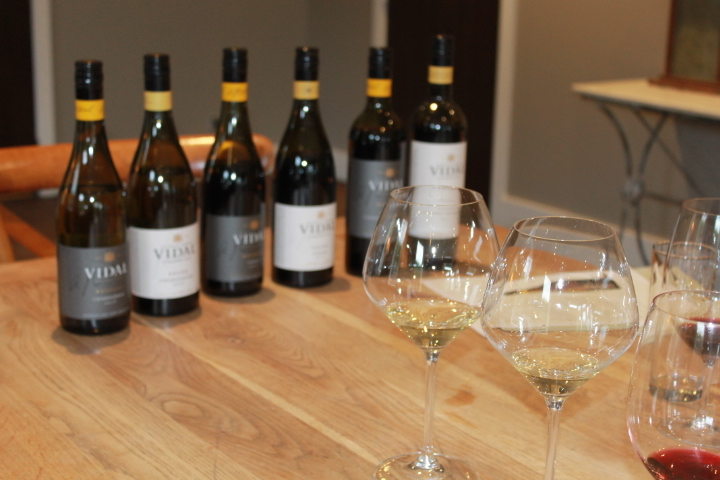
We had the Reserve and then the Legacy which sells for about $55, but nothing in between, and that’s where the Soler range comes in. In terms of winemaking you’ll see that the Reserve will have a lot more inoculated ferments – still barrel ferments but using yeasts to give it a cleaner, more fruit driven style. In Soler you’ll see a lot more whole bunch press, wild ferment, more richness, complexity and a bit more new oak.
The two main Vidal Chardonnay vineyards are the Keltern vineyard and the Kokako farms vineyard which is Ohiti Valley. We work with a grower there who is our main Hawke’s Bay grower. Quality focus, boutique grower, and a lot of it comes from there, and bit from the Lyons vineyard which is Gimblett Gravels, down towards the river. It’s quite small batch winemaking – some of the batches only have 7-8 barrels. The Soler will be hand-picked, the Reserve a bit more machine harvested, but those machines are getting so good now anyway. With the winery here, and it’s one of the main motivations, is that it’s all within ten minutes of here. Esk Valley is 45 minutes away by truck, Vidal is 30 minutes that way by truck. We can machine harvest and get whole berries and they’ll be in the winery much quicker. That’s one of the main production differences really – hand harvest or machine. By using a lot of solids in the ferment, so quite high lees and the juice isn’t really clarified – it goes into ferment on the same day that it’s pressed. So using the solids gives that flinty character and richness.
WF: do you think that ‘modern’ style with the struck match reductive character was a fad? You talk to someone in Burgundy and they’re adamant that “it’s the terroir”, and I don’t believe that it is only from the soil in the vineyard – at least to the extent that it’s been passed off as in the past?
RP: But there is a direct correlation between how nutrient-rich the soil is and the nitrogen in the must or the juice – and how the yeast performs. We notice it with Gimblett Gravels reds – there’s no soil, it’s just stones – so no nitrogen for the yeasts; and we notice that reduction in our reds. We have to supplement our red musts with an organic nutrient to provide food for the yeast. So you can argue there’s a relationship there.
But I think with Chardonnay it probably is more about solids in the juice. It’s often about not ‘fixing the ferment’. If you’re making a commercial fruit-forward wine, you can ferment it at a cool temperature, make sure the yeast is really healthy, inoculate it, feed it – and you won’t get this sulphide character. But if you just press the juice to a barrel – no matter what it is – it’s going to go a bit funky. So it’s almost a more natural way of making wine.
The way I like to think about it, wine shouldn’t have elbows – nothing should stick out too much. Whether that be the oak, the malolactic character, sulphides, acid… it should all be seamless. It comes back to balance.
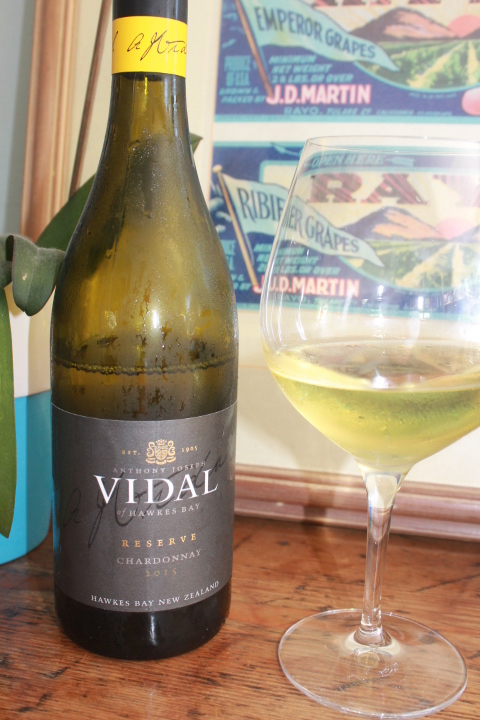
But there’s a lot to say about a house style. I think Vidal’s in particular made a name for itself making a more minerally, flinty style of Chardonnay. And there’s nothing wrong with just saying “this is our style, we’ve got a market that enjoy this style, and we’re happy to produce it in that way”. But at the same time it is a very distinctive style of wine. There’s going to be the odd personal taste that will hate it.
People say it’s more of a Burgundian style of wine, but I feel that there are just as many Burgundian chardonnays that are quite broad and rich. It’s almost a bit of a myth that they’re all tight and minerally. Or maybe I just can’t afford the ones that are!
WF: As New Zealanders, the wines we would consider our classics and sometimes ‘outrageous prices’ – of course, globally, they’re not! When you get a Quartz Reef Methode against a top Champagne and it stands up alongside, but one is $40 and the other $300 – how do you bridge that gap? How do you say to someone ‘ this is as good as that’. I don’t just mean Champagne, but Chardonnay for example… like in ‘A Seat at the Table’ Is Legacy going to become a $150 wine? Or is that not going to happen?
RP: Bob Campbell wrote an article I read last year and he said ‘five years ago I reviewed all the New Zealand wines over $100, and there were five of them. Now there’s about thirty” Or words to that effect! I think people are really thinking we should charge more for our wines. And weirdly sometimes it’s easier to sell a $150 bottle of wine than it is a $50 one. They just want to feel like they’re drinking something expensive. People have done studies where they give people the same wine, but tell them it’s worth $20, then give them the same wine and tell them it’s worth $80. And they actually scan the brain, and the “expensive” one triggers off pleasure centres in the brain, knowing that it’s more expensive. And so they feel better about drinking it.
WF: It’s good that with Vidal there’s an identifiable progression through the range – is that intentional? You have an entry point and then a ladder to climb?
RP: It’s one of the benefits of working for a company like Villa Maria. It’s nice to have those cheaper wines because what it does is improve the quality of those more expensive wines. Because you’re not having to hide wine that should go into a $20 bottle in an $85 bottle of wine. There is a logical progression in quality, concentration and complexity as you move through the range, from the fruit forward everyday drinking style of the Estate range to the hedonistic and age worthy Legacy range.
RP: Both Vidal syrahs we’re trying today are Gimblett Gravels. We have two main vineyards – one is Omahu vineyard, and then there’s the Twyford Gravels vineyard. Omahu you’ll get lovely peppery characters that’s so distinctive of syrah; and then the Twyford Gravels tends to give a bit more dark fruit and floral characters. We make the syrah like we make Pinot – treat it similar – sometimes whole bunch, certainly whole berry and we don’t extract the bejezzus out of it. Gentle extraction, and we don’t give it as much racking as we would a Bordeaux blend, so it’s about preserving some of those gentle floral aromatics that makes syrah so nice.
WF: can you explain to our readers what racking ‘does’ to a wine?
RP: Very traditional Bordeaux winemaking technique would be to have the red wines in barrel for two years. And two or three times during that lifecycle you take it out of barrel and any solids that have sunk to the bottom – you wash those out, as they can make the wine go a bit reductive. And part of the process is you just get a little dose of oxygen into the wine, and that helps soften those tannins. But Pinot Noir is quite different from that in that you press it out after fermentation and you put it into barrel but you won’t actually touch it until you blend it. So Syrah falls somewhere in between the two. Some people will go the whole Pinot method, or if it’s a really big, more Shiraz-style, they might go more towards the Bordeaux method. Here in Hawke’s Bay we’re somewhere in between the two.
Vidal wines are all aged in French oak barrels. The Reserve you’ll see a little less new oak and a more easy drinking style wine; then the Soler is a bit more serious and structured, with a bit more new oak. Two quite different vintages – 2018 was warm but a little bit wet, but the wines are soft and light. ’17 we had the most amazing summer – it was perfect drought conditions. Then in March it just starting raining so the Vintage itself was pretty trying. Both of them produces lighter wines, lower in alcohol and easier drinking styles, not necessarily ones to put away for 15 years.
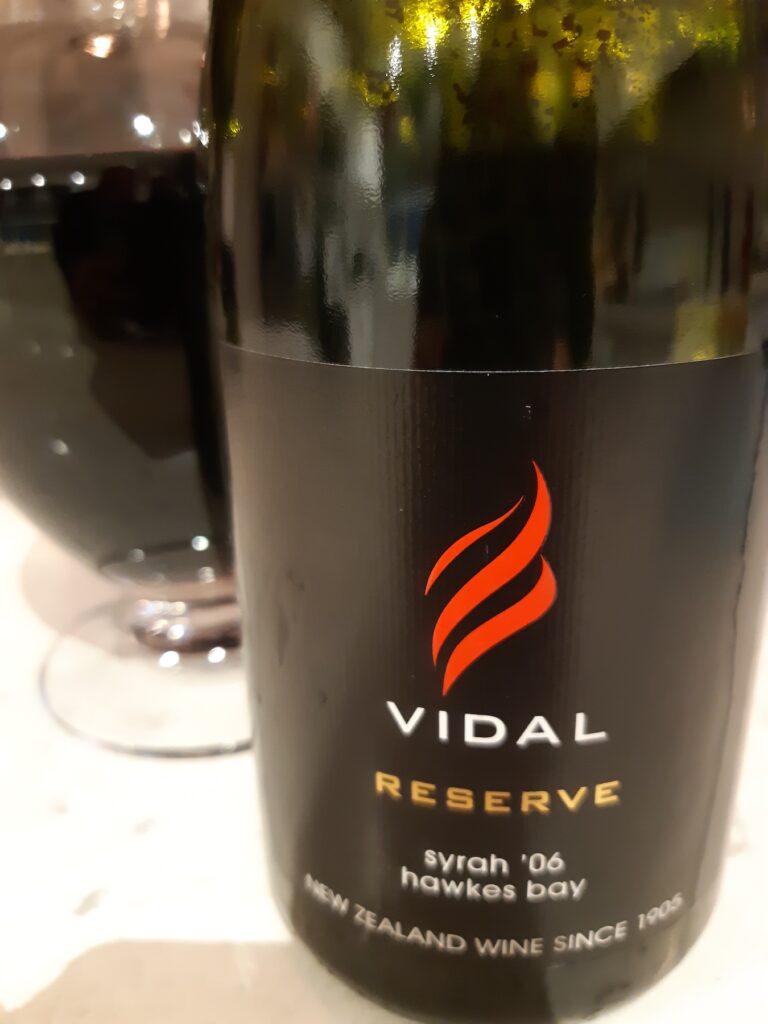
WF: I’ve heard people talk about great Vintages – the great 2013s, and how good the ‘19s are going to be – so that plays a part in the longevity?
RP: I think so. For me, only now are some of those 2013 wines starting to come around. It’s that tannin structure, and that can only be resolved in time. Whereas a lot of people say ’14 was an amazing vintage too, but the wines were so much more approachable when they were young – softer and rounder in the mouth. The ’19 wines we’ve got in barrel, they’re going to be more like ’13, really long-lived ones. And 2020 is looking the same to be honest.
WF: Yes, tell me about that – how was it?
RP: It was amazing. So, it was really random with COVID-19 but luckily we had a really early harvest here in Hawke’s Bay and were about 80% done by the time we went into Lockdown. Here at Te Awa our Chardonnay was all in before March, and normally wouldn’t start picking that until 10th March, so we were about two weeks ahead of normal. It was a bit of a stressful week because we didn’t know if we were going to be classed as essential workers until about 5.30pm on the Monday and we were worried that the Government might change their mind. We had a few red blocks out but we harvested the rest of our grapes that week.
WF: So were you in a campervan out the back?
RP: We had to put in really strict procedures. The way we ran is was anyone who lived with other people who were in Essential Services or were in risk of ‘Community Infection’, had to move on site, living in a campervan, fed three meals a day. I got lucky because Julz (my partner) was making wine too, but she moved out to her parents with our daughter Addy, so I just stayed home on my own rather than stick it out in a campervan. Normally you’d work a 12-14 hour day, so you just work and sleep. But we had to split the winery into three shifts and they couldn’t overlap, so if one person on a shift got sick, we could pull out those people but we didn’t have to shut the winery
So we only did 8 hours a day rather than 14 hours, and I was starting at two in the afternoon. So I’d wake up in the morning, cook myself breakfast, work in the garden for four hours – my garden has never looked better. So it was weird. I missed my family but I kind of enjoyed the solitude – having a bit of time out. So in respect of hours worked, it was the cruisiest harvest I’ve ever worked however those 8 hours could be quite intense. But we had to change the whole way we did things, so I think we took a lot of learnings from it to be honest and it may change how we tackle harvest in the future for the wellbeing of our staff.
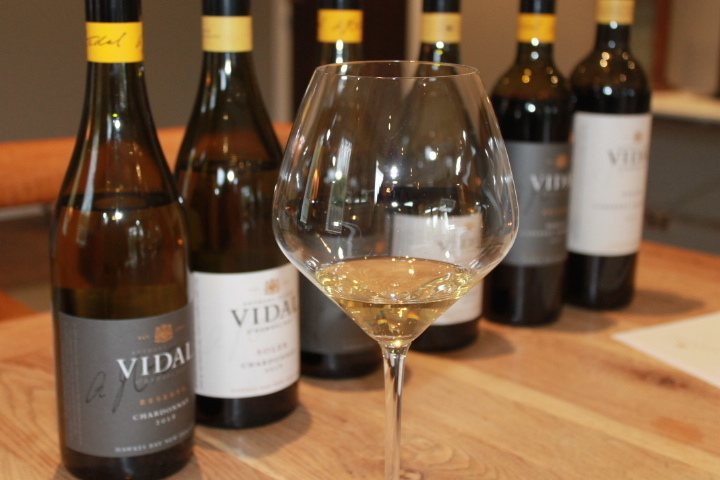
WF: What do you think the impact post COVID-19 might be for wine, and Cellar Doors?
RP: We’re in the process of deciding what to do with this space – we’ve closed for winter. We might make it a bit more casual and fun. Hawke’s bay is in a really good position because we’re not a place where tourist come to go bungy jumping, or take a helicopter ride. Only about 25% of visitors here are international tourists, so we’re not missing out at the moment and we’re quietly confident that people who might have gone to the Gold Coast or Fiji will come here and stay in a nice Air B’n’B and go to the great restaurants they’ve heard about.
WF: I like the fact that you can come here and try a range of wines – I think that really works. If you’ve driven through the Bay to get to where the bulk of the wineries out here, you’re not going to detour back to Esk Valley. Out in west Auckland, there’s a range of places – from Kumeu River that is quite formal, and then The Hunting lodge where they have craft beer and food trucks, as well as a Tasting Counter. I think Food and Wine Tourism could be quite important for the next year as we shift to a domestic tourism scenario. I believe we have great food ‘ingredients’ – it literally is a Land of Milk and Honey – that’s New Zealand! But what have we done with them – what is our identifiable cuisine? If you go to Italy, Food and Wine should be high on your list of experiences, and they’ve taken great ingredients and made amazing cuisine from that. The only thing that I can really put my finger on, for New Zealand, that has taken that farmed ingredient and transformed it – is wine.
RP: I travel a lot and presenting wines overseas, and around the table the question will come up – ‘what’s a quintessential New Zealand food?” And I’ll say a classic New Zealand dinner might be a roast lamb. But then that could be in Greece or Wales. So you’ll say what else have we got, and normally end up talking about some of the seafood like paua, which is quite unique? Chefs here in Hawke’s Bay if they’re using lamb it’s from a local farm, and other local produce.
WF: how is wine likely to be affected by the situation we’re in now?
RP: We had record sales over March and April. But I’ll caveat that with it’s all in the sub-$20 range. So, wine that is sold in supermarkets at under $20 just flew off the shelf. Not just here but in the UK was really strong too. The US has tanked for us a bit, but we have a lot more on-premise weighting there.
WF: any thoughts on Climate Change – am I going to be drinking fine wine out of Tetrapaks in my Retirement Home?
RP: I was in Norway last year – they buy a lot of LeftField wines, so they took me to one of the State wine stores, and I couldn’t get over the packaging – they had Tetrapaks, bag-in-box, but not cheap wine. And even they had these pouches, like we buy soup in a pouch… We’ve been doing a lot of work with canning, but canning wine is really hard. It’s not like any other product, with its acid and sulphur. I think what you’ll start to find is more fine wines going into lighter weight bottles, and the end of really heavy bottles. The thing about glass is that it’s the only product that can be recycled back to exactly the same grade product. Whereas every other product in the world that gets recycled gets downgraded across its lifecycle. That’s one aspect. Another thing is that is someone is careless and drops a bottle in the river or the ocean, it gets broken back down to sand, so it’s less impactful than other products.
WF: Looking into your crystal ball is there anything else ahead?
RP: We make the Te Awa Tempranillo, but Albarino is the big one for us. It’s a crisp white wine, that fits with NZ’s reputation from Sauvignon Blanc and people expect it. We are having good success in export markets with Albarino. Overseas, and the UK in particular, people know what it is – here you have to explain it. In the UK with Leftfield, we have a Sauvignon Blanc but the next biggest sellers are Rose, Albarino and a straight Malbec. It’s easier to sell a Malbec than a Merlot.
One of the reasons we like Albarino is that it’s future-proofing – it’s a very robust grape. Thick-skinned, loose bunches and not susceptible to fungal diseases at all. In Hawke’s Bay we’re leaning towards Chardonnay being our hero variety – we know we can make it really well every year. Warm vintage or cool vintage, and a nice style that blends richness but fruit and acidity. Even Kumeu River have bought a big vineyard up the road, and start converting it to Chardonnay. There’s so much room to imprint your own style on Chardonnay – it’s a real winemakers variety, probably more so than any other wine.
WF: What’s your take on the thinking that Hawke’s Bay could/should be doing more Syrah – that it’s better than the Bordeaux blends the region is perhaps best known for?
RP: I love Bordeaux Blends personally to drink, but I think Syrah is really distinctive. There’s great Cabernet made all around the world, but not the same for Syrah. The northern Rhone, the Australian version of shiraz… but the Hawke’s Bay version of Syrah, it’s much more like Pinot – it’s got that delicacy, that floral character. But there’s only 800 hectares in the whole country and it’s really finicky to grow. People say Pinot Noir is the hard one, but Syrah is so tricky to grow. It’s very temperamental, doesn’t like big temperature swings, doesn’t like wind, doesn’t like it too dry. It’s really tough to get right actually.

